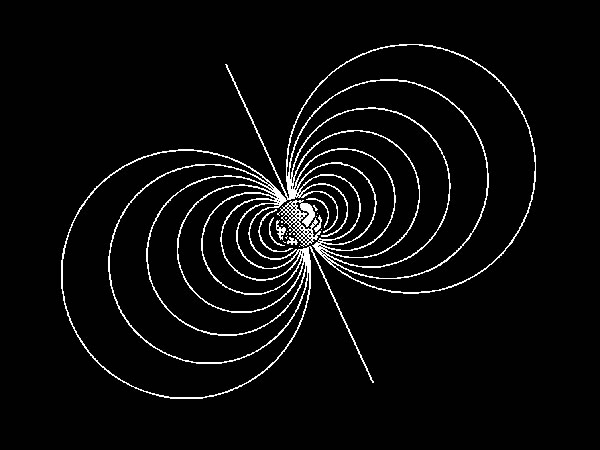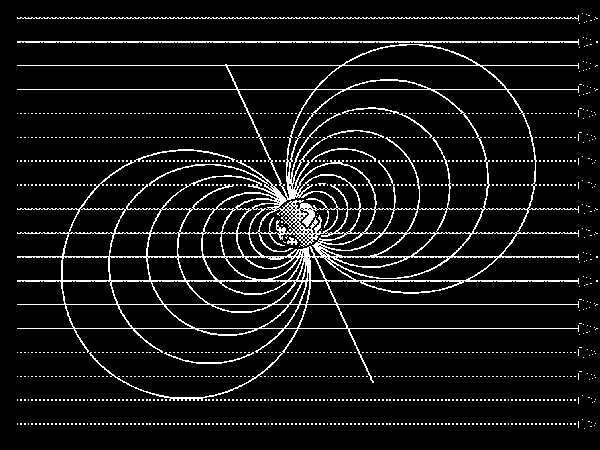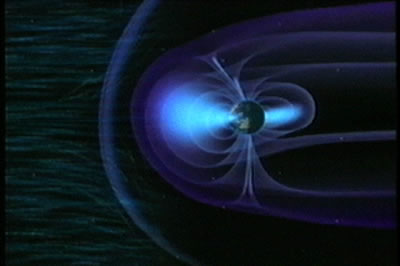Explanation of the Aurorae: The Earth’s Magnetic Field
The solar wind particles carry magnetism along with the solar wind. When the solar wind reaches the Earth the wind particles do not simply bump into our planet. The Earth is surrounded by a magnetic field. It is like a bar magnet with the poles of the magnet near the Earth’s north and south poles. To illustrate, here is a tray of iron filings and a bar magnet.
Turn on the overhead projector. Place the magnet on the overhead projector and move it around slightly to get the iron filings to line up along the magnetic field lines. Overlay the transparent plastic Earth disc to visually and in words make the connection that Earth has a magnetic field.
Alternatively, play the video clip from BLACKOUT! comparing a bar magnet and iron filings to the magnetic field of Earth interacting with the solar wind.
The magnetic field is invisible, but the tiny bits of iron line up to show how the magnetic field is arranged. It follows lines.
What part of the Earth do most of the lines come from?
[Most of the field lines touch the Earth at the poles.]
VISUAL 14 (still): Earth with Symmetrical Magnetic Field
[Use the following sequence of stills to discuss Earth’s magnetic field.]

This is Earth’s magnetic field without the solar wind
If the Earth were alone in space and its magnetic field were visible it might look something like this. The Earth, however is not alone. The Sun is nearby and the solar wind is blowing.
VISUAL 15 (still): Earth with Symmetrical Magnetic Field Unaffected Solar Wind

Earth’s magnetic field with the solar wind overlayed
But the charged particles in the solar wind cannot just flow straight by the Earth as shown here. The particles get deflected by Earth’s magnetic field.
VISUAL 16 (still): “Pushed” Solar Wind and Unaffected Magnetic Field of Earth Earth’s magnetic field pushing on the solar wind

The solar wind streams around the Earth, like we see here.
Also, the solar wind changes the Earth’s magnetic field. The field gets pushed and stretched away from the Sun into a long tail called the magnetotail.
VISUAL 17 (still): Earth with “Pushed” Magnetic Field and Solar Wind Streaming Around Earth The solar wind warping Earth’s magnetic field

The solar wind hits the Earth’s magnetic field at a million miles per hour (400 km/sec). A turbulent shock wave forms in front of the Earth, on the daytime side of the Earth facing the Sun. Some of the solar wind particles can become trapped within the Earth’s magnetic field. But the solar wind can also trigger more obvious effects as well.
VISUAL 18 (still): Magnetotail Earth’s magnetotail—a combination of the previous four stills’ effects.

The flow of the solar wind pushing and stretching the Earth’s magnetic field can release stored energy within the magnetotail. Like taffy stretched to its breaking point, the magnetotail snaps and ejects a huge cloud of charged particles into the depths of interplanetary space. Such a “bag” of electric particles was actually observed by the spacecraft “Voyager” as far out in the solar system as Jupiter.
Optional
Play video clip from BLACKOUT! of the magnetic field of Earth interacting with the solar wind.
The other part of the electrical cloud is driven along magnetic field lines down to Earth. These lines lead to the polar regions, as we saw with the bar magnet and the iron filings. The electrical cloud deposits electric power into the Earth’s upper atmosphere sort of like a giant dynamo or electric generator. A high speed flow of charged particles hits the thin upper atmosphere. A glowing halo of light, centered on the magnetic pole, forms at the boundary between open magnetic field lines (connected to Earth at one end and the solar wind at the other) and “closed field lines” (both ends connected to the Earth).

